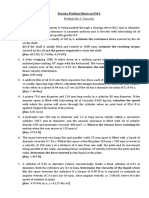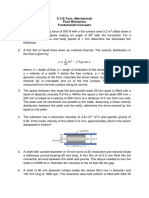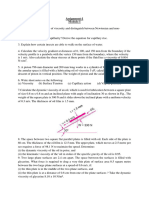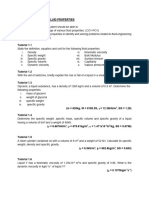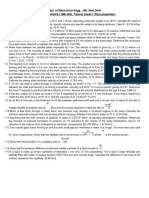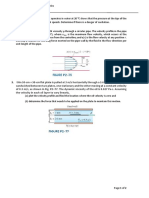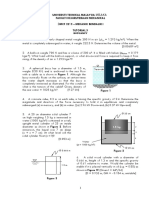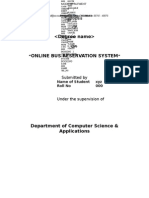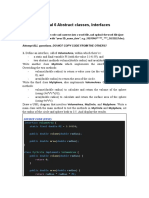Tutorial 1 - BMCG 2613 - Fluid Properties PDF
Tutorial 1 - BMCG 2613 - Fluid Properties PDF
Uploaded by
mege1105Copyright:
Available Formats
Tutorial 1 - BMCG 2613 - Fluid Properties PDF
Tutorial 1 - BMCG 2613 - Fluid Properties PDF
Uploaded by
mege1105Original Description:
Original Title
Copyright
Available Formats
Share this document
Did you find this document useful?
Is this content inappropriate?
Copyright:
Available Formats
Tutorial 1 - BMCG 2613 - Fluid Properties PDF
Tutorial 1 - BMCG 2613 - Fluid Properties PDF
Uploaded by
mege1105Copyright:
Available Formats
UNIVERSITI TEKNIKAL MALAYSIA MELAKA
FAKULTI KEJURUTERAAN MEKANIKAL
BMCF 2223 MEKANIK BENDALIR I
TUTORIAL 1
FLUID AND ITS PROPERTIES
1. (a) Calculate the weight of a reservoir of oil if it has a mass of 825 kg. [8.093 kN]
(b) If the reservoir has a volume of 0.917 m3, compute the density, specific weight, and the
specific gravity of the oil. [900 kg/m3; 8.83 kN/m3; 0.90]
2. A cylindrical can, 150 mm in diameter, is filled to a depth of 100 mm with a fuel oil. The oil
has a mass of 1.56 kg. Calculate its density, specific weight, and specific gravity. [883 kg/m3;
8.659 kN/m3; 0.883]
3. A plate, 0.5 mm distant from a fixed plate, moves at 0.25 m/s and requires a force per unit
area of 2 Pa to maintain this speed. Determine the viscosity of the substance between the
plates. [0.004 kg/ms]
4. A shaft 80 mm in diameter is being pushed through a bearing sleeve 80.2 mm in diameter
and 0.3 m long. The clearance, assumed uniform is flooded with lubricating oil of viscosity 0.1
kg/ms. (a) If the shaft moves axially at 0.8 m/s, estimate the resistance force exerted by the
oil on the shaft, (b) If the shaft is axially fixed and rotated at 1800 rpm, estimate the resisting
torque exerted by the oil and the power required to rotate the shaft. [60.32 N; 22.74 Nm;
4.29 kW]
5. A very large thin plate is centred in a gap of width 0.06 m with different oils of unknown
viscosities above and below: one viscosity is twice the other. When the plate is pulled at a
velocity of 0.3 m/s the resulting force on 1 m2 of plate due to the viscous shear on both sides
is 29 N. Assuming viscous flow and neglecting all end effects, calculate the viscosities of the
oils. [0.97 kg/ms]
6. A 50-cm x 30-cm x 20-cm block weighing
150 N is to be moved at a constant velocity 50 cm
of 0.8 m/s on an inclined surface with a 0.8 m/s
friction coefficient of 0.27. (a) Determine 30 cm
the force F that needs to be applied in F
horizontal direction. (b) If a 0.4-mm-thick oil 20
film with a dynamic viscosity of 0.012 Pa.s
is applied between the block and inclined 150 N
surface, determine the percent reduction in
the required force. [105.5 N; 45.8 %] Figure 1
7. A thin 20-cm x 20-cm flat plate is pulled
at 1 m/s horizontally through a 3.6-mm-
thick oil layer sandwiched between two
plates, one stationary and the other
moving at a constant velocity of 0.3 m/s, Fixed wall
as shown in Figure 2. The dynamic h1 = 1 mm 1 m/s
viscosity of oil is 0.027 Pa.s. Assuming the
velocity in each oil layer to vary linearly,
(a) plot the velocity profile and find the h2 = 2.6 mm
location where the oil velocity is zero and
(b) determine the force that needs to be 0.3 m/s
Figure 2
applied on the plate to maintain this
motion.
[0.6-mm from the bottom plate; 1.62 N]
8. The clutch system shown in Figure 3 is used
to transmit torque through a 3-mm-thick oil
film with = 0.38 N.s/m2 between two
Driven shaft identical 30-cm-diameter disks. When the
driving shaft rotates at a speed of 1450
30 cm rpm, the driven shaft rotates at a 1398
3 mm
rpm. Assuming a linear velocity profile for
SAE 30W oil the oil film, determine the transmitted
torque. [0.55 Nm]
Figure 3
9. The viscosity of a fluid is to be measured by a viscometer constructed of two 75-cm-long
concentric cylinders. The outer diameter of the inner cylinder is 15 cm, and the gap between
the two cylinders is 0.12 cm. The outer cylinder is fixed while the inner cylinder is rotated at
200 rpm and the toque is measured to be 0.8 Nm. Determine the viscosity of the fluid.
[0.231 N.s/m2]
10. A 1.9-mm-diameter tube is inserted into an unknown liquid whose density is 960 kg/m3, and it
is observed that the liquid rises 5 mm in the tube, making a contact angle of 15 . Determine
the surface tension of the liquid. [0.0232 N/m]
11. The belt in Figure 4 moves at a steady velocity V = 2.5 m/s and skims the top of a tank of oil
of dynamic viscosity = 0.29 kg/ms, as shown. Distance between rollers L = 2 m, width of
the belt b = 60 cm and depth of the oil h = 3 cm. Assuming a linear velocity profile in the oil,
determine (a) the resisting force exerted on the belt by the oil, and (b) the power P required
to drive the belt. (Given, P = Tw ) (Final Exam Sem 1 Session 06/07) [29 N; 72.5 watt]
L
V
Driving torque T
h Oil
Figure 4
12. Two square plates (15 mm x 15 mm) are dipped into a fluid of density = 1000 kg/m3
parallel to each other, as shown in Figure 5. If distance between the plates W = 2 mm,
determine the capillary rise h . Given, surface tension = 0.073 N/m and contact angle is
negligible, i.e. = 0 . (Test 1 Sem 1 Session 06/07) [7.44 mm]
W
Figure 5
You might also like
- CS 1103 Programming Assignment Unit 1Document8 pagesCS 1103 Programming Assignment Unit 1Tim RNo ratings yet
- MECH4407 Past Exams 002Document7 pagesMECH4407 Past Exams 002Abhi MoharanaNo ratings yet
- ProblemsDocument14 pagesProblemsSophia Varshini100% (1)
- FM-II - PS-1 - Viscous Flow PDFDocument2 pagesFM-II - PS-1 - Viscous Flow PDFSouparna Banerjee50% (2)
- Tutorial 4 - BMCG 2613 - Hydrostatic Force PDFDocument2 pagesTutorial 4 - BMCG 2613 - Hydrostatic Force PDFmege1105No ratings yet
- Tutorial 1 - Chapter 1 Fluid PropertiesDocument2 pagesTutorial 1 - Chapter 1 Fluid Propertieszul hilmiNo ratings yet
- Practice Problem Sheets On FM-I Group ADocument4 pagesPractice Problem Sheets On FM-I Group ASWAGATAM BAZNo ratings yet
- Assisgnment - 1Document1 pageAssisgnment - 1File SharingNo ratings yet
- DR Rola ME 362 Sheet 1Document4 pagesDR Rola ME 362 Sheet 1Keroles SabryNo ratings yet
- Problem Sheet 01 20-21 FL Mech Properties of FluidDocument1 pageProblem Sheet 01 20-21 FL Mech Properties of FluidAvishek BiswasNo ratings yet
- Tutorial Chapter1Document3 pagesTutorial Chapter1prakash ChapagainNo ratings yet
- TUTORIAL 1-Viscosity - 0Document8 pagesTUTORIAL 1-Viscosity - 0SharonCamilaTorresBoteroNo ratings yet
- Tutorial 1Document3 pagesTutorial 1nexowa9068No ratings yet
- ENGR 2343 - Fluid Mechanics HW#2 - Due 8/29/13 at Beginning of Class Chapter 2: Properties of FluidsDocument6 pagesENGR 2343 - Fluid Mechanics HW#2 - Due 8/29/13 at Beginning of Class Chapter 2: Properties of FluidsJoshua Rey SapurasNo ratings yet
- AssignDocument2 pagesAssignlaudaNo ratings yet
- 1.topic 1Document14 pages1.topic 1Aqillah RizalNo ratings yet
- Fundmental Concepts - ProblemsDocument2 pagesFundmental Concepts - Problemsadharb21No ratings yet
- Fluid Mechanics QtnsDocument3 pagesFluid Mechanics QtnsAnonymous NV1AeWXEo100% (1)
- Assignment 1Document3 pagesAssignment 1Ayush ShrivastavaNo ratings yet
- FP 1 Objective QuestionsDocument16 pagesFP 1 Objective Questionsbachayadav0% (2)
- The Copperbelt University School of EngiDocument3 pagesThe Copperbelt University School of Engiyousef mohamedNo ratings yet
- Problems 1Document2 pagesProblems 1kanijfahmida2020No ratings yet
- Tutorial Chapter 1 2018Document3 pagesTutorial Chapter 1 2018Ain Syahira0% (1)
- Assignment 1Document3 pagesAssignment 1Kausik BeraNo ratings yet
- Fluid Mech ProblemsDocument2 pagesFluid Mech ProblemsMarky SantosNo ratings yet
- Me-2204 FMM Internal 1Document2 pagesMe-2204 FMM Internal 1srajapratyNo ratings yet
- Tutorial Chapter 1Document6 pagesTutorial Chapter 1dhiauddinfarhiNo ratings yet
- Ce8 PS1Document2 pagesCe8 PS1Yedda M IlaganNo ratings yet
- Tuto 1Document1 pageTuto 1hahahaNo ratings yet
- 5 - EBS2313-Fluid Mechanics - Tutorial 1Document3 pages5 - EBS2313-Fluid Mechanics - Tutorial 1R.M. Pramila SathsaraniNo ratings yet
- Group Assignment No 1 Properties of Fluid (3)Document3 pagesGroup Assignment No 1 Properties of Fluid (3)Bridget Nicole BordeosNo ratings yet
- Tutorial Sheet1Document1 pageTutorial Sheet1Swati SachanNo ratings yet
- Dept. of Mechanical Engg., JMI, New Delhi FLUID MECHANICS-I (ME-306), Tutorial Sheet-1 (Fluid Properties)Document1 pageDept. of Mechanical Engg., JMI, New Delhi FLUID MECHANICS-I (ME-306), Tutorial Sheet-1 (Fluid Properties)scriptblendmediaNo ratings yet
- Fluid PropertiesDocument4 pagesFluid PropertiesBrijesh KumarNo ratings yet
- sheet 1Document2 pagessheet 1asahss06No ratings yet
- Mechanics of Fluids Question Bank PDFDocument11 pagesMechanics of Fluids Question Bank PDFSuresh Raju100% (2)
- Sheet 2 FluidDocument3 pagesSheet 2 Fluidmohamedalaas103No ratings yet
- Cie 202 Fluid Mechanics-Tute 1Document2 pagesCie 202 Fluid Mechanics-Tute 1Janushka RanasingheNo ratings yet
- Fluid Mechanics: Tutorial: 1 Date: 24/06/2015Document1 pageFluid Mechanics: Tutorial: 1 Date: 24/06/2015Er M HnNo ratings yet
- Tutorial - Lecture 1 QuestionsDocument2 pagesTutorial - Lecture 1 Questionspoojana semalNo ratings yet
- Sheet#1 Fluid ProertiesDocument3 pagesSheet#1 Fluid ProertiesmoazsrourdNo ratings yet
- Fluid Mechanics HW2Document3 pagesFluid Mechanics HW2juangar1992No ratings yet
- Problems Ch01 Ch02.2015 IDocument16 pagesProblems Ch01 Ch02.2015 ISalvador Vargas-Diaz0% (1)
- Answers With Decimals Must Be Corrected To Two Decimal PlacesDocument2 pagesAnswers With Decimals Must Be Corrected To Two Decimal PlacesMahpuja JulangNo ratings yet
- Assignment - 1Document3 pagesAssignment - 1Sanju HossainNo ratings yet
- Actividad 1Document3 pagesActividad 1Edgar López MenaNo ratings yet
- Diploma AssignmentDocument2 pagesDiploma AssignmentEmmanuel MatutuNo ratings yet
- Crowe - Cap 7Document9 pagesCrowe - Cap 7panzerkirbyNo ratings yet
- Mechanical Engineering Department Tutorial Sheet Machine Design-I, M-503Document4 pagesMechanical Engineering Department Tutorial Sheet Machine Design-I, M-503Harpinder GotraaNo ratings yet
- Assignment 4Document1 pageAssignment 4itsaman5555555No ratings yet
- Fluid MechanicsDocument3 pagesFluid MechanicsjsivabharathyNo ratings yet
- Tutorial No.6-Applications of Navier-Stokes Equation: AE 225 Fluid DynamicsDocument2 pagesTutorial No.6-Applications of Navier-Stokes Equation: AE 225 Fluid Dynamicssoumya100% (1)
- Sheet 1-Fluid DefinitionDocument2 pagesSheet 1-Fluid DefinitionUNKNOWNNo ratings yet
- 07M305 Fluid Mechanics and Machinery: Question BankDocument7 pages07M305 Fluid Mechanics and Machinery: Question BankAmarkarthik ArunachalamNo ratings yet
- Tutorial Sheet 1Document2 pagesTutorial Sheet 1oginoweijNo ratings yet
- Tut 1Document3 pagesTut 1Abbie ZiyechNo ratings yet
- Corrugated Plate InterceptorDocument8 pagesCorrugated Plate InterceptorDavid LambertNo ratings yet
- White_Ed 6_P4.87Document1 pageWhite_Ed 6_P4.87Andres SalinasNo ratings yet
- Enhanced Oil Recovery: Resonance Macro- and Micro-Mechanics of Petroleum ReservoirsFrom EverandEnhanced Oil Recovery: Resonance Macro- and Micro-Mechanics of Petroleum ReservoirsRating: 5 out of 5 stars5/5 (1)
- Analytical Modeling of Solute Transport in Groundwater: Using Models to Understand the Effect of Natural Processes on Contaminant Fate and TransportFrom EverandAnalytical Modeling of Solute Transport in Groundwater: Using Models to Understand the Effect of Natural Processes on Contaminant Fate and TransportNo ratings yet
- Title & Objectives 2. Introduction & Theory 3. Work Procedure and Apparatus 4. Discussion 5. Conclusions 6. ReferencesDocument1 pageTitle & Objectives 2. Introduction & Theory 3. Work Procedure and Apparatus 4. Discussion 5. Conclusions 6. Referencesmege1105No ratings yet
- ATJ2C-85 (Pindaan2017) - 5 - 12 - 2017 (1) (1) 60Document1 pageATJ2C-85 (Pindaan2017) - 5 - 12 - 2017 (1) (1) 60mege1105No ratings yet
- Safety Sign & Color at WorkDocument6 pagesSafety Sign & Color at Workmege1105No ratings yet
- Environmental Health and Safety Monthly ReportDocument5 pagesEnvironmental Health and Safety Monthly Reportmege1105No ratings yet
- ATJ2C-85 (Pindaan2017) - 5 - 12 - 2017 (1) (1) 62Document1 pageATJ2C-85 (Pindaan2017) - 5 - 12 - 2017 (1) (1) 62mege1105No ratings yet
- H2 - Radial Heat ConductionDocument4 pagesH2 - Radial Heat Conductionmege1105No ratings yet
- Tutorial 5 - DMCF 2213 (Buoyancy)Document2 pagesTutorial 5 - DMCF 2213 (Buoyancy)mege1105No ratings yet
- Tutorial 7 - DMCF 2213 (Energy Equation)Document3 pagesTutorial 7 - DMCF 2213 (Energy Equation)mege1105No ratings yet
- Solution Manual Tutorial IDocument4 pagesSolution Manual Tutorial Imege1105No ratings yet
- Tutorial 1 Bekg2433Document4 pagesTutorial 1 Bekg2433dansadeNo ratings yet
- Solution Tutorial VI Thermo I PDFDocument5 pagesSolution Tutorial VI Thermo I PDFmege1105100% (1)
- Tutorial 4 - BMCG 2613 - Hydrostatic Force PDFDocument2 pagesTutorial 4 - BMCG 2613 - Hydrostatic Force PDFmege1105No ratings yet
- Evolution of Management Theory: The Case of Production Management in ConstructionDocument9 pagesEvolution of Management Theory: The Case of Production Management in ConstructionPaul Watkins100% (1)
- V5055bonnet Iom 95-6981Document4 pagesV5055bonnet Iom 95-6981Gabo AyureNo ratings yet
- c200 Series Product Manual Black Bruin enDocument75 pagesc200 Series Product Manual Black Bruin enAhmed AliNo ratings yet
- Research On Influence Factors of Landing Gear Retractile HydraulicDocument5 pagesResearch On Influence Factors of Landing Gear Retractile HydraulicPrateek GadagiNo ratings yet
- Elementary Number Theory Unit-II: Sanket K. MohareDocument10 pagesElementary Number Theory Unit-II: Sanket K. Moharesharad94210No ratings yet
- Rice Transformer A Novel Integrated Management System For Controlling Rice DiseasesDocument17 pagesRice Transformer A Novel Integrated Management System For Controlling Rice DiseasesMonisha K 21BEC1313No ratings yet
- Transformers Notes - 5 PDFDocument7 pagesTransformers Notes - 5 PDFEng Ogada KelvinNo ratings yet
- How To Reset Administrator PasswordDocument7 pagesHow To Reset Administrator Passwordm1984sunilNo ratings yet
- BibliyoDocument43 pagesBibliyo20EUIT125- SAKTHI ISWARYA SNo ratings yet
- GS BScrim1ABDocument6 pagesGS BScrim1ABTrexie Mae EjobNo ratings yet
- 27 1 15 L07 L22 RS Brochure GBDocument8 pages27 1 15 L07 L22 RS Brochure GBjennlin.changNo ratings yet
- 230517-Sleeves and Sleeve Seals For Hvac PipingDocument6 pages230517-Sleeves and Sleeve Seals For Hvac PipingMohamed SokarNo ratings yet
- 3 Sequence and Language ModelingDocument56 pages3 Sequence and Language ModelingOuriNo ratings yet
- Bus Reservation SystemDocument7 pagesBus Reservation SystemArif Khan100% (3)
- Leveling Techniques & AdjustmentsDocument4 pagesLeveling Techniques & AdjustmentsAnna Daniella LunaNo ratings yet
- Steel Pipe PicklingDocument4 pagesSteel Pipe Picklingvran77No ratings yet
- Prism - Requirements OverviewDocument10 pagesPrism - Requirements OverviewVijay100% (1)
- C&P WITCHLINER Insulated 2-Bolt Pipe ClampDocument1 pageC&P WITCHLINER Insulated 2-Bolt Pipe ClampAchraf BoudayaNo ratings yet
- JNX TroubleshootingDocument2 pagesJNX TroubleshootingAnderson Oliveira SilvaNo ratings yet
- L202026100117 - Albert Richard Halim - 20211115Document12 pagesL202026100117 - Albert Richard Halim - 20211115Mr. XNo ratings yet
- GEK-132231 GE KV2c Encompass Meter Family - User Manual Rev 1.0Document131 pagesGEK-132231 GE KV2c Encompass Meter Family - User Manual Rev 1.0cepmcimcNo ratings yet
- 7 - Information SystemDocument41 pages7 - Information SystemMinh NguyệtNo ratings yet
- Dajic PCDocument2 pagesDajic PCMario CrnkovićNo ratings yet
- Big Data & Hadoop Workshop OutlinesDocument3 pagesBig Data & Hadoop Workshop OutlinesArchanaSharmaNo ratings yet
- Pioneers of HDD Reflect On Hall of Fame Careers - Underground ConstructionDocument6 pagesPioneers of HDD Reflect On Hall of Fame Careers - Underground ConstructionAO VISIONNo ratings yet
- Artificial Intelligence & Machine Learning: Search StrategiesDocument7 pagesArtificial Intelligence & Machine Learning: Search StrategiesHarshali Y. PatilNo ratings yet
- 7 - Class 7Document81 pages7 - Class 7Zum BiiNo ratings yet
- Manual Operacion Mapa Triup Trbp-06Document27 pagesManual Operacion Mapa Triup Trbp-06Samuel AcevedoNo ratings yet
- K To 12 Basic Education Curriculum Technology and Livelihood Education Learning Module Electrical Installation and MaintenanceDocument172 pagesK To 12 Basic Education Curriculum Technology and Livelihood Education Learning Module Electrical Installation and MaintenanceNguyễnTiếnĐạt100% (1)






